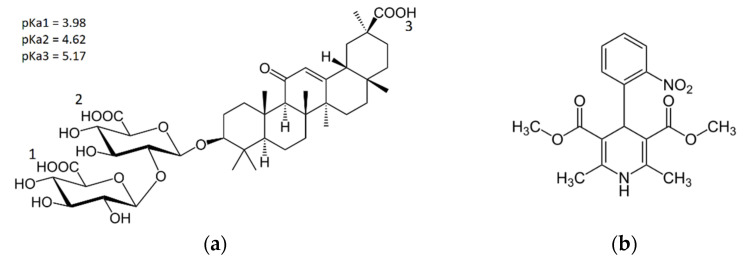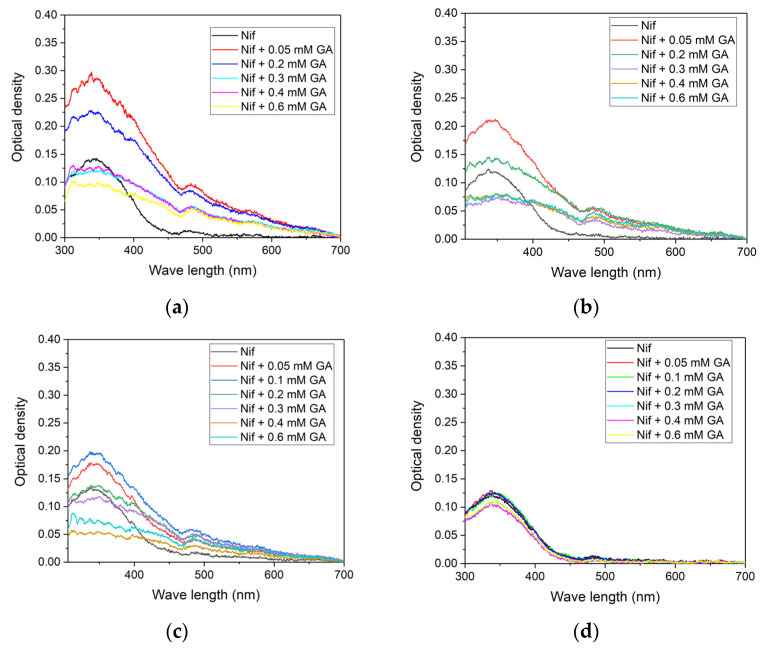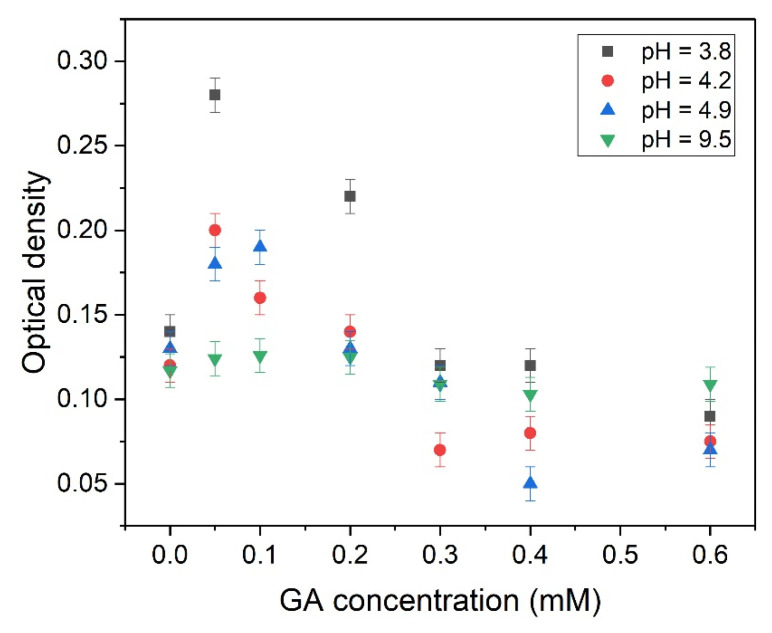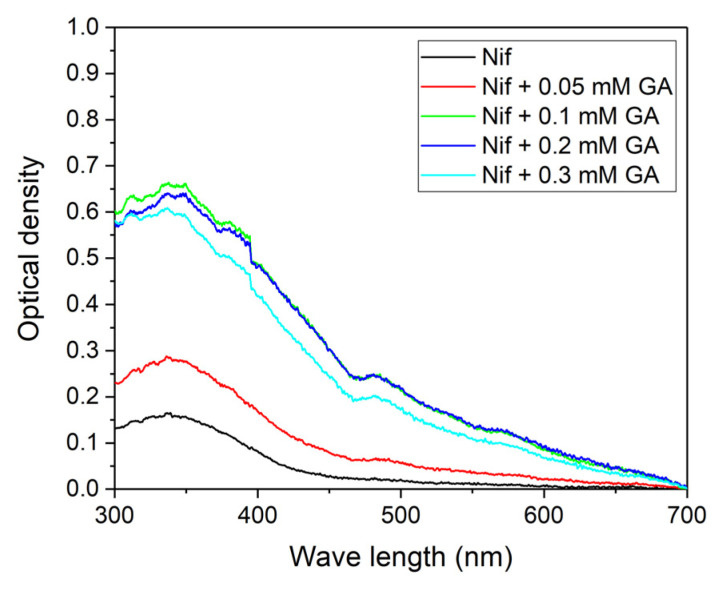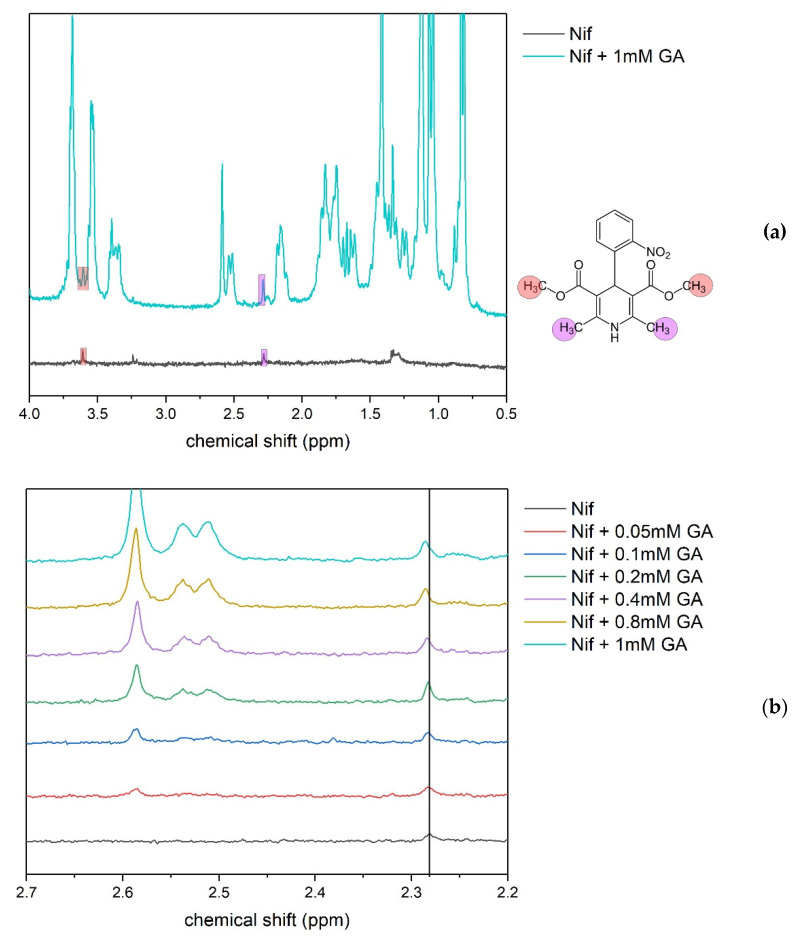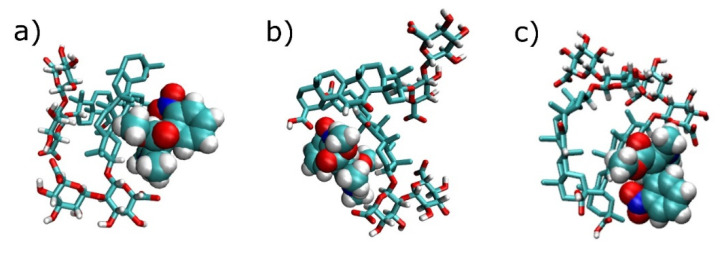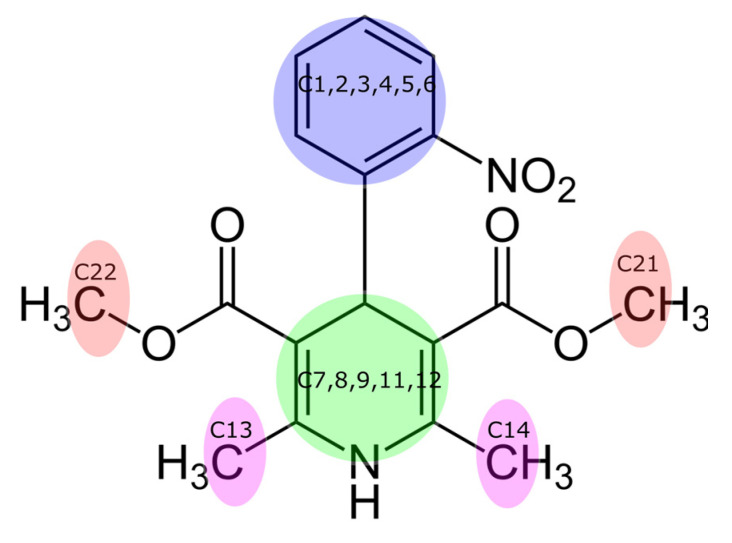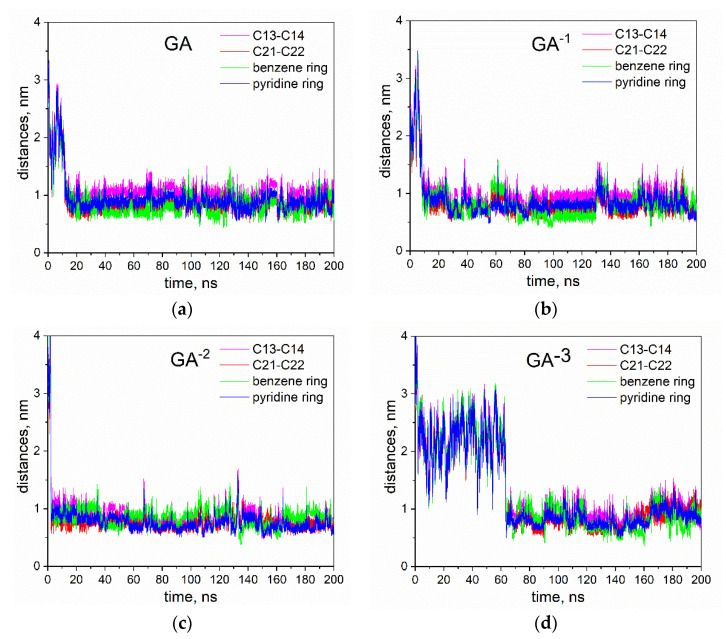Abstract
Glycyrrhizic acid, or glycyrrhizin (GA), a major active component of licorice root, has been widely used in traditional Chinese and Japanese medicine since ancient times. However, only in the last decades has a novel and unusual property of the GA been discovered to form water-soluble, supramolecular complexes with a variety of lipophilic drugs. These complexes show significant advantages over other known delivery systems, in particular, due to strong pH sensitivity, the properties of GA self-associates. In the present study, a supramolecular complex formation of the hypotensive and antiarrhythmic drug nifedipine with GA has been studied at different pH values, corresponding to the different degrees of GA dissociation, including a fully dissociated state of GA. Both NMR experiments and molecular dynamics simulations demonstrate the existence of the nifedipine complex with GA at all dissociation states of GA. However, optical absorption experiments show the decrease of complex stability and solubility at pH > 6 when the GA molecule is fully deprotonated. It means the higher release rate of the drug in a neutral and basic environment compared with acid media. These results could form the basis of follow-up studies of GA self-associates as pH-controlled drug delivery systems.
Keywords: nifedipine, glycyrrhizin, pH-controlled drug delivery systems, inclusion complexes, NMR, molecular dynamics
1. Introduction
Encapsulation of lipophilic drugs with different delivery systems is an innovative approach that increases their solubility, stability, and bioavailability. Another advantage of the encapsulation of drug molecules into nanosized delivery systems is their controlled release in the human body [1]. Various delivery systems, such as inclusion complexes, micelles, nanoemulsions, nanoliposomes, and biopolymeric nanoparticles have been tested to improve drug properties. The basic concepts of nanoencapsulation are discussed in a number of recent reviews [2,3,4,5]. These reviews show the potential of nanoencapsulation technology and cover the main encapsulation methods.
Drug delivery systems can be divided into different groups according to the method of drug release: targeted drug delivery systems, controlled drug delivery systems, and modulated drug delivery systems. To date, pH and temperature-controlled drug releases are two approaches that can be used in medicine without a complicated control system.
Targeting of drugs is a significant aspect of drug delivery systems. It is classified into active and passive. Passive targeting works through a permeability increase, while active targeting is connected with the functionalization of drug delivery systems by specific ligands that interact with the receptors of certain cell types. For all targeting types, drug release can be triggered by a change in pH, temperature, or a combination of both. The main targets in the body are the receptors on cell membranes, lipid components of the cell membrane, and antigens or proteins on the cell surfaces [6].
The absorption of an orally administrated drug is influenced by different factors (drug stability and solubility, the activity of metabolic enzymes and drug transporters, etc.). It is known that pH values are different for different parts of an organism (gastrointestinal tract, different organs, tissues, and cellular compartments). For example, the pH value of the stomach is 1.5–3.5; pH values of the small intestine vary in the 5.5–6.8 range; pH values of the colon lie between 6.4 and 7 [7]. The pH values for cancer tissues are lower than for normal tissues, and the pH values of some cellular environments could alter from others (e. g., pH of endosomes is 5.5–6.0; pH of lysosomes is 4.5-5.0) [8]. For this reason, the pH-dependent behavior of a drug plays an important role in its functioning in the body. The use of pH-controlled drug delivery systems (DDS) opens a way to control drug release and target drug delivery when the drug is released only in tissues with specific pH values.
Glycyrrhizic acid (glycyrrhizin, GA, Figure 1a) is the saponin from licorice root. Glycyrrhizin has been used in traditional Chinese and Japanese medicine since ancient times. It is widely investigated from the point of its biological activity: hepatoprotective, antiviral (including recently discovered activity against SARS-CoV-2), anticancer, etc. [9,10,11,12,13]. GA also demonstrates the ability to enhance the activity of other drugs [14,15,16,17,18,19,20,21]. In particular, it can reduce the toxicity, dose, and side effects of drugs and increase the therapeutic index [14]. This effect of glycyrrhizin has been observed, in particular, for nifedipine (NF), hypotensive, and antiarrhythmic drugs. Nifedipine complexes with GA manifested an antihypertensive therapeutic effect in a ten-fold reduced dose of nifedipine [14]. Taking into account the data indicating the decrease in the heart pressure under the use of GA [22], one can expect the synergistic effect of using the GA-NF complex. Several mechanisms for the biological activity of GA are proposed, and one of them is connected with the ability of GA to interact with cell membranes and to change membrane properties [23,24,25,26,27,28,29,30,31]. However, the explanation of the broad spectrum of the biological activity for GA is still under discussion.
Figure 1.
The chemical structure of (a) glycyrrhizic acid (GA) and (b) nifedipine.
It is known that glycyrrhizin forms self-associates (oligomers and micelles) in aqueous solutions, and its self-association depends on the pH of the media [32,33,34]. GA has three dissociation steps, with pKa values 3.98, 4.62, and 5.17 (Figure 1a, data is taken from [35]). Deprotonation of GA leads to changes in critical micelle concentration (CMC) values [32,33]. In addition, deprotonation leads to changes in the interactions of GA with lipid bilayers [33]. Therefore, such pH-dependent behavior suggests a possible application of GA as the base of a pH-controlled drug delivery system. In the present work, the properties of supramolecular associates of GA with a drug on the model of the hypotensive and antiarrhythmic drug nifedipine (Figure 1b) have been studied by the methods of nuclear magnetic resonance and molecular dynamics simulations. Earlier, it was found in vivo, that the complexes of GA with nifedipine show a significant increase (more than one order) in its therapeutic activity on the models of adrenaline-induced hypertension and CaCl2-induced arrhythmia [36].
2. Results
2.1. Optical Spectroscopy
Optical absorption spectra of the mixtures of nifedipine with GA for different pH values are given in Figure 2.
Figure 2.
Optical absorption spectra of the mixture nifedipine + GA at pH value (a) 3.8, (b) 4.2, (c) 4.9, and (d) 9.5. The GA absorption is subtracted from all spectra. Nifedipine was added in an amount exceeding the maximum solubility in water (0.5 mM was added).
The pH values of samples were chosen to achieve different degrees of dissociation of GA: pH 3.8 corresponds to fully protonated state, pH 4.2 corresponds to once deprotonated state, 4.9 corresponds to twice deprotonated state, and 9.5 (more than last pKa3 = 5.18) corresponds to fully deprotonated state (see Figure 1). The optical density in the absorption maximum of nifedipine (342 nm) with different concentrations of GA was measured for all series. The result is given in Figure 3.
Figure 3.
The dependence of the optical density of a mixture of nifedipine + GA on the concentration of GA at different pH values (3.8, 4.2, 4.9, and 9.5) at 342 nm.
It is noticeable that the concentration dependence of optical density demonstrates a similar behavior for all pH values: the increase of optical density at low GA concentration and the following decrease of optical density with the further increase of GA concentration (after the concentration of GA of about 0.1 mM). Supposedly, at low concentrations, GA could form complexes with nifedipine, which improves the solubility of the drug, which then leads to the increase of observed optical density. However, the further increase of GA concentration could lead to the formation of large insoluble aggregates and a decrease in the optical density. Similar behavior of nifedipine solubility on GA concentration was earlier detected in the water–methanol solution using an NMR technique [37]. The stoichiometry of the nifedipine-GA inclusion complex below critical micelle concentration (~1 mM) was calculated as 1:2 using Job plot measurement [37]. Besides, it is noticeable that at pH value 9.5 (a fully dissociated form of GA), the increase of optical density is absent. It could mean that the complex of nifedipine with GA at this pH is unstable.
Longer stirring (24 hours) leads to a more significant increase in the optical density of nifedipine at low GA concentrations (Figure 4). An approximately six-fold increase of optical density was observed for pH 4.9. It can be suggested that due to the low solubility of nifedipine, complex formation with GA occurs slowly, which is why longer stirring improves the solubility of the complex.
Figure 4.
Optical absorption spectra of the mixture nifedipine + GA at pH value 4.9 after 24 hours of stirring. The GA absorption is subtracted from all spectra.
2.2. Nuclear Magnetic Resonance Experiments
Fragments of 1H-NMR spectra of mixtures of nifedipine + GA with different concentrations at pH = 6 are shown in Figure 5a. Signals from aromatic protons are not observed, possibly due to the strong line broadening in the complex with GA. However, the shift of nifedipine signals corresponding to CH3 groups under the increase of GA concentration was detected (Figure 5b). This shift could be caused by the change of the nifedipine environment due to the formation of complexes with GA. It means that even at pH = 6, when the GA molecule is fully deprotonated, the complex with nifedipine is also formed.
Figure 5.
Fragments of 1H NMR spectra of mixtures nifedipine + GA at pH 6 (a,b). The assignment of nifedipine signals is taken from [38].
The ability of GA molecules to form self-associates in an aqueous solution at different pH has been studied earlier by Petrova et al., using the NMR relaxation technique [25]. However, no data are available on the pH behavior of the inclusion complexes of glycyrrhizin with drug molecules. NMR diffusion measurements have been applied to study the behavior of the nifedipine-GA complexes at different dissociation degrees of the GA molecule in aqueous solutions. NMR diffusion experiments were done for samples with pH values 3.8, 4.2, 5, 6.1, and GA concentrations of 1mM. Diffusion coefficients of GA protons are given in Table 1. Under acidic pH, GA in protonated and partially deprotonated states could form micelles with CMC dependent on the pH value [32,39]. In diffusion NMR experiments, we studied the behavior of the aggregates with a GA concentration close to CMC.
Table 1.
Diffusion coefficients (D) of GA protons in the mixtures of nifedipine + GA for samples with different pH and 1mM of GA.
| pH | D, *10−10 m2/s |
|---|---|
| 3.8 | 1.9 ± 0.3 |
| 4.2 | 2.4 ± 0.1 |
| 5 | 2.7 ± 0.1 |
| 6.1 | 2.3 ± 0.1 |
As could be seen from Table 1, the diffusion coefficient demonstrates non-linear dependence on the pH value.
The size of aggregates could be estimated from this data using the following equation:
| (1) |
where D is a diffusion coefficient; T is a temperature; a is a radius; η is a viscosity; k is the Boltzmann constant.
Using the data from Table 1, the radius of the GA-nifedipine inclusion complex is 1.3 nm. Larger aggregates (micelles) provide an impact on the observed NMR signal, but their impact on the diffusion coefficient is relatively small. Note that the size of GA micelles with incorporated drug molecules have been estimated in our earlier studies by the methods of gel permeation chromatography, dynamic light scattering, and electron microscopy. These experiments show that the size of GA micelles is in the range of 40–100 nm [40,41].
The increase of the diffusion coefficient with the increase of pH could be connected with the increase of CMC and, correspondingly, a decrease of the observed mean size of aggregates. However, the decrease of D value is observed at pH 6.1. At this pH, GA is in fully dissociated form, and such a decrease could not be connected with the micelle formation. Possibly, the changes in the structure of the nifedipine-GA complex, caused by Coulomb repulsion, could occur under these conditions, which leads to an increase in the radius of the associate. To answer this question, in this study, we have performed the molecular dynamics simulation of nifedipine-glycyrrhizin interaction at different dissociation degrees of GA molecule in an aqueous solution.
2.3. Molecular Dynamics Simulation
To demonstrate the ability of GA at different dissociation degrees to form complexes with nifedipine, the behavior of two equally charged GA ions and a nifedipine molecule in water have been investigated. As it was noted above, 2:1 is the correct stoichiometry for the GA-nifedipine complexes at low GA concentrations [37]. For all dissociation steps of GA, the formation of stable complexes with nifedipine, which did not fall apart during the simulation run (200 ns), was observed. Examples of these complexes for GA2− ion are shown in Figure 6. Apparently, same as neutral GA molecules, GA ions can form stable complexes with nifedipine in water, which can increase their solubility and facilitate its transport to and through a cellular membrane. A similar effect of GA has been recently shown for praziquantel [42].
Figure 6.
Examples of the complexes formed by two GA2− ions and a nifedipine molecule in water (a–c). Nifedipine molecule is depicted by its van der Waals radii. Water molecules and Na ions are not shown.
To characterize observed complexes, the distances between different moieties of the nifedipine molecule and the centers of mass (COM) of GA ions per simulation time were measured. These moieties and their color codes are shown in Figure 7.
Figure 7.
Moieties of a nifedipine molecule, which were used to measure distances from C13, C14 and C21, C22 carbon atoms of methyl groups, the pyridine ring and benzene ring are highlighted by magenta, red, green, and blue, respectively.
Figure 8 demonstrates the distances between different moieties of the nifedipine molecule and the COM of GA ions. The distances were calculated to the COM of both GA ions separately and then averaged. The distances from symmetrical C-atoms (C13 and C14, C21 and C22, Figure 7) were averaged too. The magenta line shows the averaged distance from C13 and C14 carbon atoms to the COM of GA ion. The red line depicts the distance from C21 and C22 atoms to the COM of GA ion, distances from the COM of the pyridine ring, and from the benzene ring are shown by green and blue, respectively. Distances were calculated for the system with neutral GA molecules and for ones with ions GA1−, GA2−, GA3−.
Figure 8.
Distances between different moieties of the nifedipine molecule and the COM of different GA ions per simulation time (a) GA (fully protonated), (b) GA1−, (c) GA2−, (d) GA2−. Colors for different moieties are taken from Figure 7.
For all investigated systems, the formation of the complex of a nifedipine molecule and both GA molecules/ions (sharp decrease for all distances depicts the formation of the complex) was observed, and these complexes were retained during simulation runs.
Table 2 contains the distances from different moieties of the nifedipine molecule to the COM of GA, averaged over the last 100 ns of simulation time (in all runs, the molecules were in the complex during this period) and their standard deviation. The table also includes the distances between the centers of mass of the nifedipine molecule and GA.
Table 2.
Distances (nm) between different groups of the nifedipine molecule and the center of mass (COM) of GA ions obtained from Figure 4, averaged over the last 100 ns of simulation time.
| GA Ionization Form | COM of GA—C13-14 | COM of GA—C21-22 | COM of GA—Benzene Ring | COM of GA—Pyridine Ring | COM of GA—COM of Nifedipine |
|---|---|---|---|---|---|
| GA | 0.99 ± 0.14 | 0.80 ± 0.11 | 0.83 ± 0.15 | 0.86 ± 0.12 | 0.78 ± 0.10 |
| GA1− | 0.95 ± 0.14 | 0.76 ± 0.12 | 0.78 ± 0.18 | 0.82 ± 0.12 | 0.74 ± 0.12 |
| GA2− | 0.79 ± 0.15 | 0.77 ± 0.12 | 0.84 ± 0.16 | 0.73 ± 0.12 | 0.73 ± 0.11 |
| GA3− | 0.88 ± 0.21 | 0.79 ± 0.23 | 0.79 ± 0.19 | 0.84 ± 0.15 | 0.78 ± 0.15 |
Although the measured distances have rather large variances caused by the relative movement of the molecules in the complexes, from Figure 8 and Table 2, one can see particular structural patterns. In the case of neutral GA molecules, the average distance from the C13-C14 carbons of the methyl groups (attached to the pyridine ring) to the center of mass of the GA, is noticeably larger than the distances from other groups of nifedipine to the GA COM. This is clearly seen in Figure 8. Almost all the time the molecules were in the complex (20–200 ns), the magenta line is higher than others. At the same time, the distance between the COMs of the nifedipine and the GA molecule is the shortest. Similar correlations retain for the complex with GA1− ion and are absent in the case of GA2− and GA3− ions. Note also that the distances for the complexes with GA ions, especially with GA3− ion, have larger standard deviances. We believe that it can be the evidence of a less regular and possibly less stable structure of the complexes of nifedipine with GA ions compared with ones for neutral GA molecules. However, we highlight that all observed complexes both for GA molecules and GA ions were retained during simulations.
3. Materials and Methods
3.1. Materials
Nifedipine (1,4-dihydro-2,6-dimethyl-4-(2′-nitrophenyl)-3,5-pyridinedicarboxylic acid dimethyl ester, Sigma-Aldrich, St. Louis, MO, USA) and Glycyrrhizic acid (GA), a saponin from Licorice root (98%, Shaanxi Pioneer Biotech, Shaanxi, China), were used as supplied. 1H-NMR measurement spectra were performed in a D2O (Sigma-Aldrich, 99.9%) solution.
3.2. Optical Spectroscopy
Four series of samples with different pH values (3.8, 4.2, 4.9, and 9.5) were prepared. GA concentration in each series was varied in the range 0–0.6 mM. Nifedipine was added in an amount exceeding the maximum solubility in water (0.5 mM was added). All samples were stirred for 1.5 hours before measurement. Measurements were done on spectrophotometer SF-2000 (Spectrum, Russia) in a 1 cm quartz cuvette.
3.3. NMR Experiments
Series of samples with pH 6 was prepared for studying the possibility of a complex formation under GA dissociation. Nifedipine (2 mM) and GA with concentrations in the range 0–1 mM were placed in D2O with an amount of KOD that was necessary to achieve pH = 6. Samples were stirred for 1.5 hours before measurement. Diffusion measurements were done for pH values 3.8, 4.2, 5, and 6.1. All NMR measurements were made on Bruker AVANCE III (500MHz) spectrometer (Billerica, MA, USA).
3.4. Molecular Dynamics Simulations
The simulations were performed using the Gromacs 5.0.7 package and GROMOS54a7 force field (University of Groningen, Groningen, Netherlands). Topologies of GA ions with different dissociation steps GA1−, GA2−, and GA3− were obtained using the Automated Topology Builder [43]. GA dissociation steps and corresponding constants pK are shown in Figure 1. The data are taken from [35]. Topologies of GA and nifedipine (NF) molecules were taken from the Automated Topology Builder (ATB) database. SPC water model was used. Each molecular dynamics (MD) model contained the number of Na ions needed to neutralize the total system charge. The simulations were performed in the NPT ensemble. Pressure (1 bar) was maintained by the isotropic Parrinello–Rahman barostat [44]. Constant temperature T = 310 K was maintained using Nose–Hoover thermostat [45] with the relaxation time of 2 ps. For electrostatic interactions, the Particle Mesh Ewald (PME) method with the fourth-order of cubic interpolation and the grid of 0.16 was used [46]. Initial configurations of the system represent two GA ions of equal dissociation step or neutral molecules and a nifedipine molecule located separately and surrounded by water (~10,000 water molecules). System size was about 7 × 7 × 7 nm. One production run of 200 ns duration for each dissociation step of GA (GA, GA1−, GA2−, GA3−) was calculated.
4. Conclusions
Complex formation of the hypotensive drug nifedipine with glycyrrhizic acid was observed at different pH values, corresponding to the different degrees of GA dissociation, including a fully dissociated state of GA. However, optical absorption experiments show that the increase of nifedipine solubility in the mixture with GA is significantly lower when the GA is fully deprotonated. Besides, the results of the measurements of the diffusion coefficient of GA indicate a change in the structure of the complex when GA is fully deprotonated. Such results could mean the changes in the structure of the nifedipine-GA complex in the solution with pH > 6 and a decrease of complex stability. It means the higher release rate of the drug in a neutral and basic environment compared with acid media. The radius of the GA-nifedipine inclusion complex estimated from diffusion experiments is equal to 1.3 nm. This value is in agreement with molecular dynamics simulation data.
In the present paper, the pH-sensitivity of the structure and stability of GA-nifedipine complexes have been demonstrated. For practical use, it means that the complex preparation should be done in acidic media, but drug release will be more effective in the neutral or slightly alkaline media. It could be connected with the decrease of the complex stability due to Coulomb repulsion. These results could form the basis of follow-up studies of GA self-associates as pH-controlled drug delivery systems.
Abbreviations
| CMC | critical micelle concentration |
| COM | center of mass |
| DDS | drug delivery system |
| GA | glycyrrhizic acid |
| MD | molecular dynamics |
| NF | nifedipine |
| NMR | nuclear magnetic resonance |
Author Contributions
Investigation, O.Y.S., A.V.M. and E.A.S.; writing—original draft preparation, O.Y.S., E.A.S. and N.E.P.; writing—review and editing, O.Y.S., E.A.S. and N.E.P.; funding, O.Y.S. All authors have read and agreed to the published version of the manuscript.
Funding
The study was financially supported by the Council for grants of the President of the Russian Federation (grant № MK-1580.2021.1.3) and by Russian Ministry of Science and Education (projects № 0304-2017-0009 and 0301-2019-0005).
Data Availability Statement
The data presented in this study are available on request from the corresponding author.
Conflicts of Interest
The authors declare no conflict of interest. The funders had no role in the design of the study; in the collection, analyses, or interpretation of data; in the writing of the manuscript, or in the decision to publish the results.
Sample Availability
Samples of the compounds are not available from the authors.
Footnotes
Publisher’s Note: MDPI stays neutral with regard to jurisdictional claims in published maps and institutional affiliations.
References
- 1.Advanced Drug Delivery Systems: Technologies and Global Markets: PHM006H/BCC Research. [(accessed on 15 February 2021)]; Available online: https://www.bccresearch.com/market-research/pharmaceuticals/advanced-drug-delivery-systems-phm006h.html.
- 2.Lopalco A., Denora N. Nanoformulations for drug delivery: Safety, toxicity, and efficacy. In: Nicolotti O., editor. Computational Toxicology: Methods and Protocols. Springer; New York, NY, USA: 2018. pp. 347–365. Methods in Molecular Biology. [DOI] [PubMed] [Google Scholar]
- 3.Focsan A.L., Polyakov N.E., Kispert L.D. Supramolecular carotenoid complexes of enhanced solubility and stability—The way of bioavailability improvement. Molecules. 2019;24:3947. doi: 10.3390/molecules24213947. [DOI] [PMC free article] [PubMed] [Google Scholar]
- 4.Jafari S. Nanoencapsulation Technologies for the Food and Nutraceutical Industries. 1st ed. Academic Press; Cambridge, MA, USA: 2017. [Google Scholar]
- 5.Soukoulis C., Bohn T. A Comprehensive overview on the micro- and nano-technological encapsulation advances for enhancing the chemical stability and bioavailability of carotenoids. Crit. Rev. Food Sci. Nutr. 2017;58:1–36. doi: 10.1080/10408398.2014.971353. [DOI] [PubMed] [Google Scholar]
- 6.Yu X., Trase I., Ren M., Duval K., Guo X., Chen Z. Design of Nanoparticle-Based Carriers for Targeted Drug Delivery. [(accessed on 14 February 2021)]; doi: 10.1155/2016/1087250. Available online: https://www.hindawi.com/journals/jnm/2016/1087250/ [DOI] [PMC free article] [PubMed]
- 7.Zhu Y.-J., Chen F. PH-Responsive drug-delivery systems. Chem. Asian J. 2015;10:284–305. doi: 10.1002/asia.201402715. [DOI] [PubMed] [Google Scholar]
- 8.Yang Q., Wang S., Fan P., Wang L., Di Y., Lin K., Xiao F.-S. PH-Responsive carrier system based on carboxylic acid modified mesoporous silica and polyelectrolyte for drug delivery. Chem. Mater. 2005;17:5999–6003. doi: 10.1021/cm051198v. [DOI] [Google Scholar]
- 9.Pompei R., Flore O., Marccialis M.A., Pani A., Loddo B. Glycyrrhizic acid inhibits virus growth and inactivates virus particles. Nature. 1979;281:689–690. doi: 10.1038/281689a0. [DOI] [PubMed] [Google Scholar]
- 10.Shibata S. A drug over the millennia: Pharmacognosy, chemistry, and pharmacology of licorice. Yakugaku Zasshi. 2000;120:849–862. doi: 10.1248/yakushi1947.120.10_849. [DOI] [PubMed] [Google Scholar]
- 11.Ming L.J., Yin A.C.Y. Therapeutic effects of glycyrrhizic acid. Nat. Prod. Commun. 2013;8:415–418. doi: 10.1177/1934578X1300800335. [DOI] [PubMed] [Google Scholar]
- 12.Yu S., Zhu Y., Xu J., Yao G., Zhang P., Wang M., Zhao Y., Lin G., Chen H., Chen L., et al. Glycyrrhizic acid exerts inhibitory activity against the spike protein of SARS-CoV-2. Phytomedicine. 2020;153364 doi: 10.1016/j.phymed.2020.153364. [DOI] [PMC free article] [PubMed] [Google Scholar]
- 13.Bailly C., Vergoten G. Glycyrrhizin: An alternative drug for the treatment of COVID-19 infection and the associated respiratory syndrome? Pharmacol. Ther. 2020;214:107618. doi: 10.1016/j.pharmthera.2020.107618. [DOI] [PMC free article] [PubMed] [Google Scholar]
- 14.Tolstikova T.G., Bryzgalov M.V.K., Bryzgalov A.O. The Complexes of Drugs with Carbohydrate-Containing Plant Metabolites as Pharmacologically Promising Agents. [(accessed on 3 October 2019)]; doi: 10.2174/138955709789878123. Available online: http://www.eurekaselect.com/85315/article. [DOI] [PubMed]
- 15.Yang Y., Shi Q., Liu Z., Li R., Pan P., Hou Y., Lu W., Bai G. The synergistic anti-asthmatic effects of glycyrrhizin and salbutamol. Acta Pharmacol. Sin. 2010;31:443–449. doi: 10.1038/aps.2009.207. [DOI] [PMC free article] [PubMed] [Google Scholar]
- 16.Stakhneva E.M., Vavilin V.A., Ragino Y.I., Safronova O.G., Shintyapina A.B., Ivanova M.V. Effects of simvaglyzin and atorvaglyzin on the expression of 3-Hydroxy-3-Methyl-Glutaryl-CoA reductase in rat liver. Bull. Exp. Biol. Med. 2013;156:63–65. doi: 10.1007/s10517-013-2278-y. [DOI] [PubMed] [Google Scholar]
- 17.Yang F.-H., Zhang Q., Liang Q.-Y., Wang S.-Q., Zhao B.-X., Wang Y.-T., Cai Y., Li G.-F. Bioavailability enhancement of paclitaxel via a novel oral drug delivery system: Paclitaxel-loaded glycyrrhizic acid micelles. Molecules. 2015;20:4337–4356. doi: 10.3390/molecules20034337. [DOI] [PMC free article] [PubMed] [Google Scholar]
- 18.Konkina I.G., Shitikova O.V., Lobov A.N., Murinov Y.I., Bachurin S.O. Host-guest complexation in the β-Glycyrrhizic Acid–2,8-Dimethyl-5-[2´-(6″-Methylpyridin-3″-Yl)Ethyl]-2,3,4,5-Tetrahydro-1H-Pyrido[4,3-b]indole system. Russ. Chem. Bull. 2015;64:1385–1393. doi: 10.1007/s11172-015-1021-4. [DOI] [Google Scholar]
- 19.Wang Y., Zhao B., Wang S., Liang Q., Cai Y., Yang F., Li G. Formulation and evaluation of novel glycyrrhizic acid micelles for transdermal delivery of podophyllotoxin. Drug Deliv. 2016;23:1623–1635. doi: 10.3109/10717544.2015.1135489. [DOI] [PubMed] [Google Scholar]
- 20.Dushkin A.V., Meteleva E.S., Tolstikova T.G., Khvostov M.V., Dolgikh M.P., Tolstikov G.A. Complexing of pharmacons with glycyrrhizic acid as a route to the development of the preparations with enhanced efficiency. Chem. Sustain. Dev. 2010;4:437–444. [Google Scholar]
- 21.Lekar’ A.V., Vetrova E.V., Borisenko N.I., Yakovishin L.A., Grishkovets V.I. Mass spectrometry of triterpene glycosides molecular complexation with purine bases of nucleic acids. Russ. J. Bioorganic Chem. 2011;37:609. doi: 10.1134/S1068162011050116. [DOI] [PubMed] [Google Scholar]
- 22.Singh K., Zaw A.M., Sekar R., Palak A., Allam A.A., Ajarem J., Chow B.K.C. glycyrrhizic acid reduces heart rate and blood pressure by a dual mechanism. Molecules. 2016;21:1291. doi: 10.3390/molecules21101291. [DOI] [PMC free article] [PubMed] [Google Scholar]
- 23.Salvi M., Fiore C., Armanini D., Toninello A. Glycyrrhetinic acid-induced permeability transition in rat liver mitochondria. Biochem. Pharmacol. 2003;66:2375–2379. doi: 10.1016/j.bcp.2003.08.023. [DOI] [PubMed] [Google Scholar]
- 24.Fiore C., Salvi M., Palermo M., Sinigaglia G., Armanini D., Toninello A. On the mechanism of mitochondrial permeability transition induction by glycyrrhetinic acid. Biochim. Biophys. Acta BBA. 2004;1658:195–201. doi: 10.1016/j.bbabio.2004.05.012. [DOI] [PubMed] [Google Scholar]
- 25.Harada S. The broad anti-viral agent glycyrrhizin directly modulates the fluidity of plasma membrane and HIV-1 envelope. Biochem. J. 2005;392:191–199. doi: 10.1042/BJ20051069. [DOI] [PMC free article] [PubMed] [Google Scholar]
- 26.Sapra B., Jain S., Tiwary A.K. Transdermal delivery of carvedilol containing glycyrrhizin and chitosan as permeation enhancers: Biochemical, biophysical, microscopic and pharmacodynamic evaluation. Drug Deliv. 2008;15:443–454. doi: 10.1080/10717540802327047. [DOI] [PubMed] [Google Scholar]
- 27.Selyutina O.Y., Shelepova E.A., Paramonova E.D., Kichigina L.A., Khalikov S.S., Polyakov N.E. Glycyrrhizin-induced changes in phospholipid dynamics studied by 1H NMR and MD simulation. Arch. Biochem. Biophys. 2020;686:108368. doi: 10.1016/j.abb.2020.108368. [DOI] [PubMed] [Google Scholar]
- 28.Selyutina O.Y., Polyakov N.E., Korneev D.V., Zaitsev B.N. Influence of glycyrrhizin on permeability and elasticity of cell membrane: Perspectives for drugs delivery. Drug Deliv. 2016;23:848–855. doi: 10.3109/10717544.2014.919544. [DOI] [PubMed] [Google Scholar]
- 29.Selyutina O.Y., Apanasenko I.E., Kim A.V., Shelepova E.A., Khalikov S.S., Polyakov N.E. Spectroscopic and molecular dynamics characterization of glycyrrhizin membrane-modifying activity. Colloids Surf. B. 2016;147:459–466. doi: 10.1016/j.colsurfb.2016.08.037. [DOI] [PubMed] [Google Scholar]
- 30.Selyutina O.Y., Polyakov N.E. Glycyrrhizic acid as a multifunctional drug carrier—From physicochemical properties to biomedical applications: A modern insight on the ancient drug. Int. J. Pharm. 2019;559:271–279. doi: 10.1016/j.ijpharm.2019.01.047. [DOI] [PMC free article] [PubMed] [Google Scholar]
- 31.Selyutina O.Y., Apanasenko I.E., Polyakov N.E. Membrane-modifying activity of glycyrrhizic acid. Russ. Chem. Bull. 2015;64:1555–1559. doi: 10.1007/s11172-015-1040-1. [DOI] [Google Scholar]
- 32.Petrova S.S., Schlotgauer A.A., Kruppa A.I., Leshina T.V. Self-association of glycyrrhizic acid. NMR Study. Z. Phys. Chem. 2017;231:839–855. doi: 10.1515/zpch-2016-0845. [DOI] [Google Scholar]
- 33.Glazachev Y.I., Schlotgauer A.A., Timoshnikov V.A., Kononova P.A., Selyutina O.Y., Shelepova E.A., Zelikman M.V., Khvostov M.V., Polyakov N.E. Effect of glycyrrhizic acid and arabinogalactan on the membrane potential of rat thymocytes studied by potential-sensitive fluorescent probe. J. Membr. Biol. 2020;253:343–356. doi: 10.1007/s00232-020-00132-3. [DOI] [PubMed] [Google Scholar]
- 34.Borisenko S., Lekar A., Milov A., Vetrova E., Borisenko N. Mass-spectrometry and quantum-chemical study of self-association processes of glycyrrhizinic acid molecules. Chem. Plant Mater. 2013;2:85–92. doi: 10.14258/jcprm.1321085. [DOI] [Google Scholar]
- 35.Zeng C.-X., Hu Q. Determination of the Polyacid Dissociation Constants of Glycyrrhizic Acid. CSIR; Pretoria, South Africa: 2008. [Google Scholar]
- 36.Tolstikova T.G., Sorokina I.V., Brisgalov A.O., Dolgich M.P., Lifshitz G.I., Chvostov M.V. The Use of a New Approach to Prevention and Therapy of Acute Arterial Hypertension with Complex of Well-Known Drugs With Vegetable Glycosides (Experimental Study) [(accessed on 21 January 2021)]; Available online: https://www.rpcardio.com/jour/article/view/1005.
- 37.Polyakov N.E., Khan V.K., Taraban M.B., Leshina T.V. Complex of calcium receptor blocker nifedipine with glycyrrhizic acid. J. Phys. Chem. B. 2008;112:4435–4440. doi: 10.1021/jp076850j. [DOI] [PubMed] [Google Scholar]
- 38.Morales-Ríos M.S., De la Cerda Medina A., Pérez-Alvarez V., Joseph-Nathan P. 1H and 13C NMR study of the antihypertensive drugs nifedipine, nicardipine and related compounds. Magn. Reson. Chem. 2000;38:680–683. doi: 10.1002/1097-458X(200008)38:83.0.CO;2-B. [DOI] [Google Scholar]
- 39.Matsuoka K., Miyajima R., Ishida Y., Karasawa S., Yoshimura T. Aggregate formation of glycyrrhizic acid. Colloids Surf. Physicochem. Eng. Asp. 2016;500:112–117. doi: 10.1016/j.colsurfa.2016.04.032. [DOI] [Google Scholar]
- 40.Zhang Q., Polyakov N.E., Chistyachenko Y.S., Khvostov M.V., Frolova T.S., Tolstikova T.G., Dushkin A.V., Su W. Preparation of curcumin self-micelle solid dispersion with enhanced bioavailability and cytotoxic activity by mechanochemistry. Drug Deliv. 2018;25:198–209. doi: 10.1080/10717544.2017.1422298. [DOI] [PMC free article] [PubMed] [Google Scholar]
- 41.Meteleva E.S., Chistyachenko Y.S., Suntsova L.P., Khvostov M.V., Polyakov N.E., Selyutina O.Y., Tolstikova T.G., Frolova T.S., Mordvinov V.A., Dushkin A.V., et al. Disodium salt of glycyrrhizic acid—A novel supramolecular delivery system for anthelmintic drug praziquantel. J. Drug Deliv. Sci. Technol. 2019;50:66–77. doi: 10.1016/j.jddst.2019.01.014. [DOI] [Google Scholar]
- 42.Kim A.V., Shelepova E.A., Selyutina O.Y., Meteleva E.S., Dushkin A.V., Medvedev N.N., Polyakov N.E., Lyakhov N.Z. Glycyrrhizin-assisted transport of praziquantel anthelmintic drug through the lipid membrane: An experiment and MD simulation. Mol. Pharm. 2019;16:3188–3198. doi: 10.1021/acs.molpharmaceut.9b00390. [DOI] [PubMed] [Google Scholar]
- 43.Stroet M., Caron B., Visscher K.M., Geerke D.P., Malde A.K., Mark A.E. Automated topology builder version 3.0: Prediction of solvation free enthalpies in water and hexane. J. Chem. Theory Comput. 2018;14:5834–5845. doi: 10.1021/acs.jctc.8b00768. [DOI] [PubMed] [Google Scholar]
- 44.Parrinello M., Rahman A. Polymorphic transitions in single crystals: A new molecular dynamics method. J. Appl. Phys. 1981;52:7182–7190. doi: 10.1063/1.328693. [DOI] [Google Scholar]
- 45.Hoover W.G. Canonical dynamics: Equilibrium phase-space distributions. Phys. Rev. A. 1985;31:1695–1697. doi: 10.1103/PhysRevA.31.1695. [DOI] [PubMed] [Google Scholar]
- 46.Essmann U., Perera L., Berkowitz M.L., Darden T., Lee H., Pedersen L.G. A smooth particle mesh ewald method. J. Chem. Phys. 1995;103:8577–8593. doi: 10.1063/1.470117. [DOI] [Google Scholar]
Associated Data
This section collects any data citations, data availability statements, or supplementary materials included in this article.
Data Availability Statement
The data presented in this study are available on request from the corresponding author.



